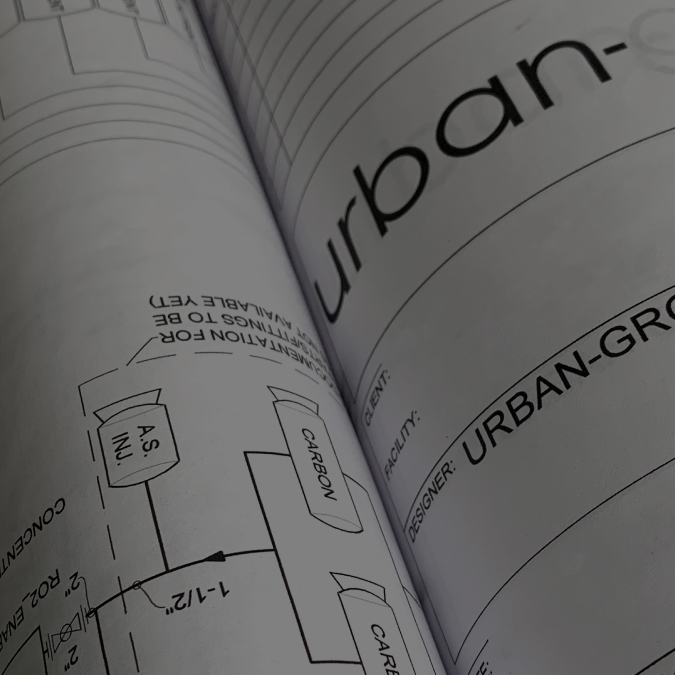urban-gro helps maximize the economic yield of new and existing cultivation facilities via our Integrated Pest Management services. Learn how to identify the most common pest pressures we typically see in facilities.
Two spotted spider mite (tetranychus urticae)
Identification
- Oval in shape
- 1/50 inch long
- Greenish-yellow to translucent in color
- Large dark ventral lateral spots are body waste
- 1st larval stage only has 6 legs
Nymphs, adult males, and reproductive adult females are oval and generally yellow or greenish in color and have one or more dark spots on each side of their bodies. Two-spotted spider mite eggs are about 0.14 mm in diameter and are usually laid on the undersides of leaves. They are spherical,
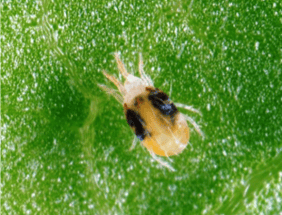 clear, and colorless when laid but become pearly white as
clear, and colorless when laid but become pearly white as hatch approaches. Two-spotted mites suck cell contents from leaves, initially stippling leaves with a fine pale green mottling. As feeding continues, the stippling increases resulting in the leaves turning yellow with bronzed or brown areas. Undersides of the infected leaves may have several mite exoskeletons. The webbing on flowers and foliage is a sign of a serious infestation. Yield and quality are severely affected when large mite populations are allowed to proliferate unchecked.
Western Flower Thrips (Frankliniella occidentalis)
Identification
- Hemimetabolous Metamorphosis: Egg – Larva I and II – Pupa I and II - Adult
- Fully developed wings
- Less than 2mm in length
- Three color morphs: (1) dark-brown (2) light (3) yellow with a dark longitudinal band along the dorsum of the thorax and the abdomen
Thrips are often found in the flower buds. These flowers may be tapped or lightly shaken over a white sheet of paper (a drop cloth, of sorts) where you will be able to see their slender, small bodies racing around. Each adult is elongated and thin, with two pairs of long wings. The eggs are oval or kidney-shaped, white, and about 0.2 mm long. The larva is
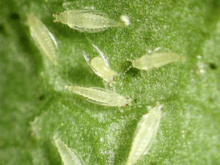 yellowish in color with red eyes. Thrips (encompasses both singular and plural versions) are not only known for the direct plant damage they cause; however, also for the plant diseases they vector. Damage to the leaves results in light colored silvery patches or streaking, often with blackish thrips droppings in the vicinity. A female may lay as little as 40 and possibly in excess of 100 eggs in the tissues of the plant, often in the flower, but also in the leaves. The newly hatched nymph feeds on the plant during the larval stage and then falls off the plant to complete the pupal stage in the soil/substrate. The insect damages the plant in several ways. The major damage is caused by the adult oviposition in the plant tissue. The plant is also injured by feeding, which leaves holes and areas of silvery discoloration when the plant reacts to the insect’s saliva.
yellowish in color with red eyes. Thrips (encompasses both singular and plural versions) are not only known for the direct plant damage they cause; however, also for the plant diseases they vector. Damage to the leaves results in light colored silvery patches or streaking, often with blackish thrips droppings in the vicinity. A female may lay as little as 40 and possibly in excess of 100 eggs in the tissues of the plant, often in the flower, but also in the leaves. The newly hatched nymph feeds on the plant during the larval stage and then falls off the plant to complete the pupal stage in the soil/substrate. The insect damages the plant in several ways. The major damage is caused by the adult oviposition in the plant tissue. The plant is also injured by feeding, which leaves holes and areas of silvery discoloration when the plant reacts to the insect’s saliva.Rice Root Aphid (Rhopalosiphum abdominalis/rufiabdominalis)
Identification
- Hemimetabolous Metamorphosis: Egg – Nymph - Adult
- Apterous (wingless) nymphs are 1.8 mm in length
- Green-bluish body with brown-black head, siphunculi and cauda.
- Alate (winged) adults are black with a blue-green abdomen.
- Alate (winged) adults have a body length of 1.4-2.4 mm.
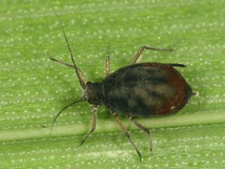 lts are produced, which fly to look for more host plants to feed on. Winged root aphids can be found on lower foliage of the plant but usually die outside of the soil environment along with any eggs laid on lower foliage. The winged version can also be caught in yellow sticky cards. To the naked eye, they look much like fungus gnats, but with magnification, they have shorter, hairy antennae while aphids have a longer filament type antennae. Also, fungus gnats have one pair of wings while aphids have two. Root aphids suck plant nutrients from the roots, often leading to mineral deficiencies in the plant when populations are high and left untreated. Root aphids in high populations can reduce plant yield. Loss in quality that we see is due to the reduction in plant yield and loss of vigor.
lts are produced, which fly to look for more host plants to feed on. Winged root aphids can be found on lower foliage of the plant but usually die outside of the soil environment along with any eggs laid on lower foliage. The winged version can also be caught in yellow sticky cards. To the naked eye, they look much like fungus gnats, but with magnification, they have shorter, hairy antennae while aphids have a longer filament type antennae. Also, fungus gnats have one pair of wings while aphids have two. Root aphids suck plant nutrients from the roots, often leading to mineral deficiencies in the plant when populations are high and left untreated. Root aphids in high populations can reduce plant yield. Loss in quality that we see is due to the reduction in plant yield and loss of vigor.Fungus Gnat (Bradysia spp.)
Identification
-
Adult fungus gnats are approximately 1/8 inch long.
-
Legs and wings comparatively long with long antennae as well.
-
Small rounded head with moderately prominent eyes that meet above the base of the thread-like antennae.
-
Larvae are white, slender and legless with a black head and smooth semi-transparent skin revealing digestive tract contents.
- Larvae are approximately ¼ inch in length when fully grown.
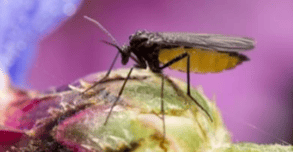 formation and thus root initiation. In addition, adults and larvae have been implicated in the transmission of plant fungal diseases, including Pythium and Fusarium. Larvae may transmit fungal plant diseases via their excretions. Adults may transmit these diseases via excretion or by carrying spores of disease organisms on their bodies. Severe infestations of fungus gnats can lead to flying adults getting caught in sticky buds, thus reducing the marketability of the crop.
formation and thus root initiation. In addition, adults and larvae have been implicated in the transmission of plant fungal diseases, including Pythium and Fusarium. Larvae may transmit fungal plant diseases via their excretions. Adults may transmit these diseases via excretion or by carrying spores of disease organisms on their bodies. Severe infestations of fungus gnats can lead to flying adults getting caught in sticky buds, thus reducing the marketability of the crop.Powdery Mildew (Sphaerotheca macularis)
Identification
- Powdery Mildew fungi are obligate, biotrophic parasites.
- During the growing season, hyphae are produced on both the dorsal and ventral sides of the leaf surfaces; however, some species are restricted to one leaf surface only.
- Haustoria, also know as specialized absorption cells, extend into the plant epidermal cells to obtain nutrition.
- Conidia, produced on the plant surfaces, either develop singly or in chains and ultimately contribute to the production of new sexual spores.
Powdery mildew is one of the most common pests of cannabis and is one of the easier plant diseases to identify as its symptoms are quite distinctive. Infections occur when powdery mildew spores (conidia) contact a suitable host and environmental conditions are favorable. Initial symptoms are small, circular, powdery, white
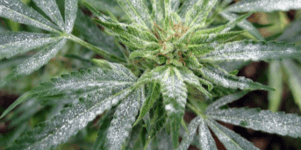 spots which expand and eventually join as infections progress. Shaded and crowded leaves are often the most affected; however, powdery mildew can appear on any above-ground part of the plant. Powdery mildew fungi grow as thin layers of mycelium (fungal tissue) on the surface of the affected plant part. Specialized absorption cells, termed haustoria, extend into the plant epidermal cells to obtain nutrition. Spores, which are the primary means of dispersal, make up the bulk of the white, powdery growth visible on the plant’s surface and are produced in chains that can be seen with a hand lens. Powdery mildew affects the rate of photosynthesis, thus reducing plant brix levels as well as plant health. Powdery mildew is common on cannabis grown indoors, in greenhouses, and outside.
spots which expand and eventually join as infections progress. Shaded and crowded leaves are often the most affected; however, powdery mildew can appear on any above-ground part of the plant. Powdery mildew fungi grow as thin layers of mycelium (fungal tissue) on the surface of the affected plant part. Specialized absorption cells, termed haustoria, extend into the plant epidermal cells to obtain nutrition. Spores, which are the primary means of dispersal, make up the bulk of the white, powdery growth visible on the plant’s surface and are produced in chains that can be seen with a hand lens. Powdery mildew affects the rate of photosynthesis, thus reducing plant brix levels as well as plant health. Powdery mildew is common on cannabis grown indoors, in greenhouses, and outside.Hemp Russet Mite (Aculops cannabicola)
Identification
- Elongate body with pale color.
- All legs extend anteriorly from the front of the head
- Need 15-20x magnification for observation of physical characteristics.
A single russet mite is too tiny to be seen by the human eye without magnification of 14x and higher. Their near invisibility makes these mites a particular threat to become established in your commercial grow before you realize it. Unlike spider mites, these voracious plant pests leave no webbing or other secretions when present. Visible damage to the
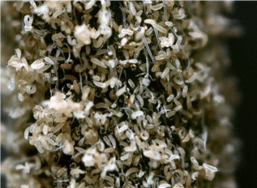 plant is th e first indication of their presence. The first sign is generally curled leaflet edges, just above the petiole. Russet mites tend to start at the bottom of a plant and work their way up the plant. Seen through a lens or microscope, russet mites are torpedo-shaped, translucent/yellow tinted, maggot-looking creatures, especially in groups. Unlike most varieties of mites, eriophyid, including russet mites, have only two pairs of legs. Russet mites live and feed mainly on leaves and petioles. They puncture the plant epidermal cells to feed on the plant cell contents. Feeding damage causes leaflets to curl at their edges, followed by a rusting discoloration and necrosis. Leaves and petioles become brittle. Flower buds on the bottom of infected plants will often be much smaller, discolored and significantly less developed than normal. Severe hemp russet mite infestations can turn leaves beige. If left unchecked, hemp russet mites will often completely destroy a cannabis plant over the course of an 8-week flowering cycle. They congregate on the upper part of the plant as it dies. Hemp russet mites can also vector viruses.
plant is th e first indication of their presence. The first sign is generally curled leaflet edges, just above the petiole. Russet mites tend to start at the bottom of a plant and work their way up the plant. Seen through a lens or microscope, russet mites are torpedo-shaped, translucent/yellow tinted, maggot-looking creatures, especially in groups. Unlike most varieties of mites, eriophyid, including russet mites, have only two pairs of legs. Russet mites live and feed mainly on leaves and petioles. They puncture the plant epidermal cells to feed on the plant cell contents. Feeding damage causes leaflets to curl at their edges, followed by a rusting discoloration and necrosis. Leaves and petioles become brittle. Flower buds on the bottom of infected plants will often be much smaller, discolored and significantly less developed than normal. Severe hemp russet mite infestations can turn leaves beige. If left unchecked, hemp russet mites will often completely destroy a cannabis plant over the course of an 8-week flowering cycle. They congregate on the upper part of the plant as it dies. Hemp russet mites can also vector viruses.Pythium Root Rot (Pythium spp.)
Identification
- Pythium is primarily a seedling disease.
- Root tips are brown and dead.
- Plants yellow and die.
- Brown tissue on the outer portion of the root easily pulls off leaving a strand of vascular tissue exposed.
- The cells of roots contain round, microscopic, thick-walled spores.
Pythium root rot can develop at any time during the growing season if the soil remains saturated, warm, or depleted of oxygen for prolonged periods. Pythium root rot is a persistent problem in areas that are poorly drained or over-irrigated. From a distance, root symptoms can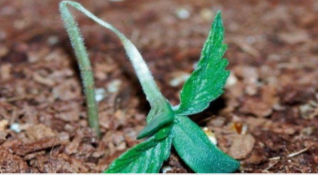 appear orange, yellow, or dark and greasy. Slowed growth and soft plants (low turgor pressure) is often the first sign that will be seen. We recommend lab tests to confirm the species so treatment plans can be tailored. Pythium attacks either juvenile tissues, such as the root tip, or roots damaged by mishandling or invertebrate pest damage. After gaining entrance to the root the fungus may cause a rapid, black rot of the entire primary root and may even move up into the stem tissue. As the substrate dries, new roots may be produced and the plant may recover or never show symptoms of disease. The depth and density of roots will be drastically reduced in affected areas. Under continued anaerobic conditions, more and more roots are killed and the plant may wilt, stop growing, or even collapse and die. This often occurs in the presence of fungus gnats.
appear orange, yellow, or dark and greasy. Slowed growth and soft plants (low turgor pressure) is often the first sign that will be seen. We recommend lab tests to confirm the species so treatment plans can be tailored. Pythium attacks either juvenile tissues, such as the root tip, or roots damaged by mishandling or invertebrate pest damage. After gaining entrance to the root the fungus may cause a rapid, black rot of the entire primary root and may even move up into the stem tissue. As the substrate dries, new roots may be produced and the plant may recover or never show symptoms of disease. The depth and density of roots will be drastically reduced in affected areas. Under continued anaerobic conditions, more and more roots are killed and the plant may wilt, stop growing, or even collapse and die. This often occurs in the presence of fungus gnats.
Having issues with pest pressures in your facility? Get a compliant IPM program to increase your plant performance with an urban-gro tailored program for your facility. Contact us at ugipm@urban-gro.com or fill out our form here.
urban-gro for Experienced CEA Facility Systems Design
urban-gro, Inc.® (Nasdaq: UGRO) is a global engineering and design services company focused on the commercial horticulture market. With experience in hundreds of Controlled Environment Agriculture (CEA) facilities spanning millions of square feet, we engineer, design, and integrate complex environmental equipment systems into high-performance facilities. Once operational, urban-gro’s gro-care® Managed Services Platform leverages the company's expertise to reduce downtime, provide continuity, and drive facility optimization. Operating as a crop-agnostic solutions provider in both food and cannabis CEA sectors, our crop-focused end-to-end approach provides a single point of accountability across all aspects of growing operations. Visit urban-gro.com to discover how we help you gro plants and gro profits.



